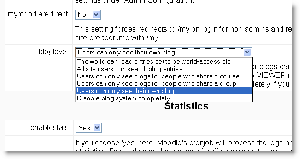Blogs: Difference between revisions
No edit summary |
|||
| Line 9: | Line 9: | ||
==Blog visibility== | ==Blog visibility== | ||
[[Image:Blogsettings.gif|thumb|Setting blog visibility in Moodle 1.6]] | [[Image:Blogsettings.gif|thumb|Setting blog visibility in Moodle 1.6]] | ||
Blogs are awsome to use on moodle. So get in front of the tv with moodles on moodle and sing this rap with me! boom-clap-boom-de-clap-de-clap!:) | |||
Site-wide blog visibility is set by an administrator via the bloglevel setting in ''Administration > Security > [[Site policies]]''. | Site-wide blog visibility is set by an administrator via the bloglevel setting in ''Administration > Security > [[Site policies]]''. | ||
Revision as of 21:02, 23 September 2010
The word 'blog' is a contraction of 'web log'. Blogs are a form of online journal used by millions of people around the world for self-expression and communicating with family and friends. Blogs are usually organized as a chronological series of postings created by the author of the blog. Blogs usually are written by one person, although some blogs can be authored by groups of people.
Blogs in Moodle are user based - each user has their own Blog. Admins, teachers, and students can create Tags - Admins can create site level tags, teachers can create Course level tags, and students can create their own list of tags.
When a blog entry is created, a user can select which tags they wish to associate with their new entry. Multiple tags can be selected. Users can also select who they want the blog entry to be available to (depending on the blog visibility site setting).
Blog visibility
Blogs are awsome to use on moodle. So get in front of the tv with moodles on moodle and sing this rap with me! boom-clap-boom-de-clap-de-clap!:)
Site-wide blog visibility is set by an administrator via the bloglevel setting in Administration > Security > Site policies.
By default, all site users can see all blogs. Blog visibility may be restricted so that users can only see blogs for people whom they share a course with or whom they share a group with. A further option is to disable blogs completely.
Note: Blog visibility is different from the options a user can publish their blog entry to. For example, if the blog visibility is set to "Users can only see blogs for people who share a course", then a user will have two publish options - "yourself" or "anyone on this site". If they select "anyone on this site" then, because of the blog visibility setting, only other course members will be able to view their entry.
Blogs outside of Moodle
Many companies and organisations on the web provide blog sites and they are generally free. The largest company to do this is Blogger which is owned by Google. All you need to do is sign up for a free Gmail account. Edublogs also provides students and teachers with an easy to use interface for blogging. Edublogs does not require students to use email addresses to log in, which is nice because some school districts don't have email addresses for students- especially at the elementary level.
There are also many Open Source web applications that can be downloaded and installed freely. The most common of these is Wordpress.
JW: Update 8.27.08 for Moodlerooms assignment
See also
- Blogs FAQ
- Using Moodle book Chapter 11: Blogs
- Development:Blogs
- Elgg
- Using Moodle Blogs forum
- Using Moodle Blogs and comments forum discussion
- Wikipedia on Blogs
Moodle and blogs are a great mix. Log on to Moodle and start blogging write away! How to use: I'm not sure exactly so don't ask me??? If you need help: Just search blogs like I did in the search section on the moodle web page. Thanks Know!:) mmmm hmmmm moodles are sure good.
